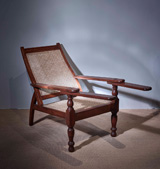STRUCTURAL FEATURES: The plantation chair (or planter’s chair) is commissioned by the British during their rule in India for their own use as well as to be shipped to Britain. They would soon become a common sight at waiting rooms of railway stations in India. Traditionally made out of mahogany, rosewood or teak, it has a dense, low seat woven out of rattan or cane, and a reclining, tilted back. Designed for comfort, it is called the easy chair or the chaise longue. It is composed of two long arms, the lower section of which swivels to turn and extend into footrests, allowing the user to put their legs up to sleep. It continues to be a popular fixture in most spacious homes, libraries and clubhouses in present-day Mumbai, Kolkata and Goa, and lends itself well to the indoors as well as the outdoors.
STYLISTIC FEATURES: The chair has sturdy legs, designed in a way that a series of rounded ridges or grooves are carved vertically at regular intervals — on the front legs in this case. Modelled after ancient Greek and Roman motifs, the pattern would flourish in the later Neoclassical, Regency and Colonial styles that developed during the 19th century. The reeded leg is similar to a fluted leg, except that the former is convex as opposed to concave. The rear legs are of the sabre or the slayed style, flaring out marginally.



PLANTATION CHAIR
DESIGNER: Unknown
MATERIAL: Wood with a cane or rattan seat
STYLISTIC INFLUENCE: Colonial
DESIGNER: Unknown
MATERIAL: Wood with a cane or rattan seat
STYLISTIC INFLUENCE: Colonial

